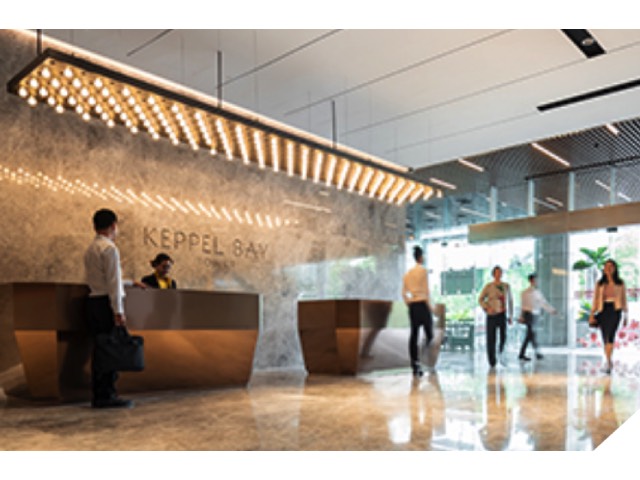From 1 January 2020, Keppel Bay Tower will be the first commercial development in Singapore to utilise renewable energy to power all its operations, including the offices of tenants in the building. Keppel Bay Tower is a Green Mark Platinum building certified by the Building and Construction Authority of Singapore (BCA).
Keppel Land, the owner and operator of Keppel Bay Tower, will be installing an assembly of PV panels spanning about 400m2 on the roof of the 18-storey Keppel Bay Tower, as well as its six-storey podium block. In addition, Keppel Land, through its electricity retailer, Keppel Electric, will be purchasing Renewable Energy Certificates (RECs), which are generated from photovoltaic (PV) panels installed in Keppel Offshore & Marine’s yards in Singapore.
When completed in 1Q 2020, Keppel Bay Tower’s PV system is expected to generate an energy yield of about 100,000 kilowatt hour (kWh) per annum. Keppel’s latest initiative to install PV panels at Keppel Bay Tower reduces the building’s reliance on grid power. Together with the purchase of RECs, these initiatives will result in a reduction of over 2,400 tonnes of carbon emissions per annum – an amount which would otherwise require about 12,000 trees to absorb over about 50 years.
Mr Tan Swee Yiow, CEO of Keppel Land, said, “Keppel is committed to sustainability, both as a provider of solutions for sustainable urbanisation and as a responsible corporate citizen. We will continue to take proactive steps to enhance the environmental performance of our developments to build a more sustainable future for all our stakeholders.”
These initiatives are part of Keppel’s continued efforts to transform Keppel Bay Tower into Singapore’s first Super Low-Energy High-Rise Existing Commercial Building.
In 2018, Keppel Land was awarded a grant of about $1.28 million by BCA to testbed new and emerging technologies which would reduce the building’s energy consumption significantly and improve its energy efficiency by 20% compared to other Green Mark Platinum buildings by June 2020.
Mr Hugh Lim, CEO of Building and Construction Authority, said, “We commend Keppel Land for its efforts in playing a part to push the boundaries for environmental sustainability in the Built Environment. The efforts for Keppel Bay Tower demonstrate a good example of how even existing large commercial buildings can tap on innovation to achieve Super Low Energy (SLE) status, by combining smart air-conditioning and lighting with integrated controls. The reduced energy demand can be met by renewables harnessed onsite and offsite through Keppel Land’s holistic approach. We hope more building owners and industry players will be inspired to set new benchmarks for how we build and operate buildings – new and existing – contributing to the urgent task of mitigating climate change through Super Low Energy Buildings.”
Keppel is currently on track to meet its goal of reducing the annual energy consumption of Keppel Bay Tower to 115 kWh/m2 per annum from its initial consumption of about 145 kWh/m2 per annum by June 2020. Keppel Bay Tower is also working with tenants to adopt green leases and install energy-efficient LED lamps in their offices at no additional capital investments to the tenants, as well as helping them attain Green Mark certification. Moving ahead, Keppel Land is also actively seeking new solutions to further reduce the building’s energy consumption to below 100 kWh/m2 per annum, which would result in Keppel Bay Tower being 50% more energy efficient compared to typical office buildings in Singapore.
A leading green developer, Keppel Land has garnered a total of 83 BCA Green Mark Awards, of which 16 are Platinum. The total estimated reduction in energy consumption from all of Keppel Land’s Green Mark-awarded projects when they are fully completed will be over 200 million kWh per annum, which is the equivalent amount of energy required to power more than 38,000 homes1 in Singapore for one year. This translates to cost savings of about $42 million annually. This is in addition to total annual water savings of about two million cubic metres and annual carbon emission reduction of almost 90,000 tonnes.








































